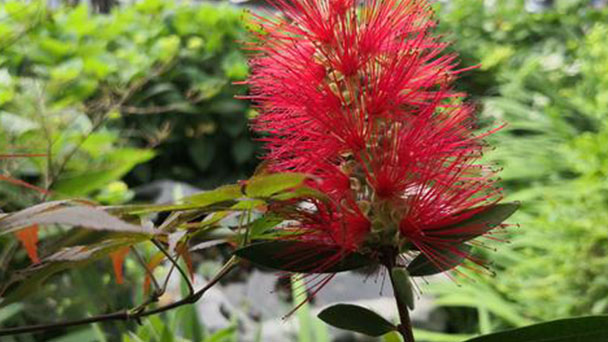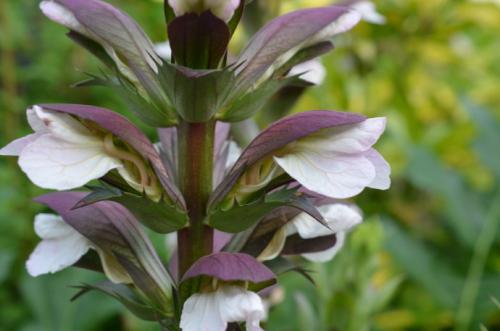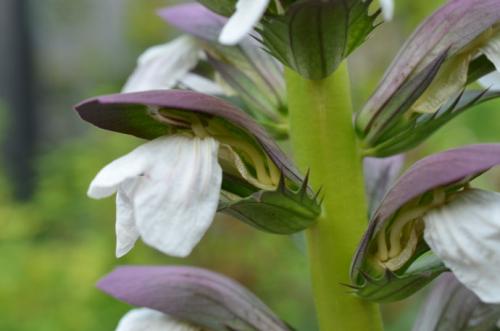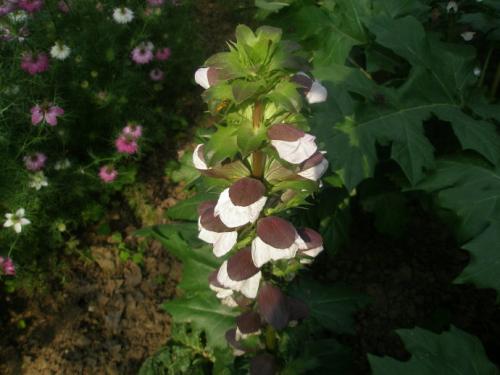Bears Breeches (Acanthus Mollis) Profile
Written by Maggie
Dec 06 2021

Bear's Breeches (Acanthus mollis) is an evergreen erect subshrub, caespitose, plant height 50~90cm, opposite leaves, pinnately divided or lobed. Bear's Breeches flowering in spring, fruiting in summer.
Bear's Breeches Picture

Bear's Breeches Info
| Botanical Name | Acanthus mollis |
| Common Names | Bear's Breeches, Oyster Plant |
| Plant Type | Perennial |
| Sun | Part shade to full shade |
| Hardiness Zones | 6 to 10; they can often survive winter down to Zone 5, but can be a gamble in a harsh winter |
| Flower color | White flowers grow on tall (3 feet) flower stalks and are hooded by purple bracts |
| Native Area | Southern Europe and Mediterranean region |
| Mature size | 3 to 6 feet tall and 3 to 6 feet wide |
Characteristics of Bear's Breeches
Bear's Breeches Strain
Bear's Breeches are an evergreen erect subshrub, caespitose, plant height 50 -- 90 cm.
Bear's Breeches Leaf
The leaves of a Bear's Breeches are opposite, pinnately divided or lobed.
Bear's Breeches Flowers
Inflorescence of Bear's Breeches are spicate, terminal, large bracts, numerous florets, white to maroon, shaped like a duck's bill, corolla 2 lips, upper lip minuscule into a single lip, lower lip large and spreading.
Bear's Breeches bloom in spring.
Bear's Breeches Fruit
Bear's Breeches is the capsule.
Bear's Breeches are fruiting in summer.
Ecological Habits of Bear's Breeches
Bear's Breeches prefer fertile, loose, well drained neutral to slightly acidic soils.
The optimum growth temperature of Bear's Breeches is 15℃-28℃. All or half sunshine is acceptable.
How to Grow and Care for Bear's Breeches
Bear's Breeches Light Requirements
Bear's Breeches will do high-quality in full solar to partial shade. They want greater safety in warm climates, however anyplace you develop them, they want at least a few hours of solar to bloom well.
Bear's Breeches Soil Care
Bear’s Breeches like a prosperous soil with lots of compost or different natural matter. Once established, they are greatly accommodating about terrible soil, however they in reality want true drainage, specifically in winter. Sitting in cold, moist soil can reason the roots to rot and may additionally kill the plants.
Bear's Breeches Watering
Once established, Bear's Breeches are very drought resistant. They are first-rate with ordinary water. An inch a week needs to be plenty.
Bear's Breeches Temperature & Humidity Care
These vegetation are dependably hardy. Protect your plant life at some point of their first couple of winters with a thick layer of mulch. In Zones 6 and lower, proceed this exercise for the existence of your plants.
Bear's Breeches Fertilizer
Bear's Breeches are no longer heavy feeders. Start with a prosperous soil and facet gown yearly with compost. You can use a balanced fertilizer in spring or mid-summer if the vegetation seem to be like they want it.
Pruning Bear's Breeches
In warm climates, the plant life can be reduced after flowering. This will motivate clean new foliage. Gardeners with bloodless winters have to depart the flora standing and permit the leaves to shield the crown. Wait till you see new growth, in the spring, to reduce any broken or declining leaves.

Bear's Breeches Pests & Diseases
Insects don’t typically trouble Bear’s Breeches, however these excellent leaves can be prone to a handful of diseases, with powdery mildew being the ordinary culprit. Good air circulation and a dose of selfmade fungicide will assist with that.
Insects: Aphids may additionally come to be a trouble in the thick leaves and slugs and snails will disguise out and feed, if the soil is damp.
Diseases: Powdery mildew, different fungal leaf spot diseases, and bacterial leaf spot can be an issue.
Propagating Bear's Breeches
There are a few methods you can correctly propagate Bear's Breeches:
Starting from Seed: If you can locate the seed, the first-class time to begin Bear’s Breeches from seed is in spring. You can begin seed indoors or direct sow, however count on to wait countless years for them to bloom. They want time to develop and set up their root machine earlier than they begin to ship out flower buds.
Division: Bear's Breeches have lengthy faucet roots and do no longer like to be moved. If you favor dividing your plants, the satisfactory way to do it is to thrust a shovel via the base of the plant’s roots, in fall, leaving the plant in place. The following spring, you must see various new “baby” flora that can without difficulty be transplanted.
Cuttings: You can additionally multiply your plant life through taking root cuttings in both the spring or fall.
Varieties of Bear's Breeches
Acanthus balcanicus var. hungaricus Hungarian Bear's Breech: The most extensively adaptable species, it blooms later and is much less inclined to late frosts.
Acanthus mollis Common Bear’s Breeches: This is the most famous species, however it can additionally be the most temperamental about blooming, with buds being broken by way of late spring frosts.
Acanthus. spinosus Spiny Bear’s Breeches: This is greater adaptable than A. mollis and greater thistle-like.
Distribution of Bear's Breeches
Bear's Breeches are native to southern Europe, northern Africa and subtropical southwestern Asia.
Garden Use of Bear's Breeches
Bear's Breeches' potted plants are suitable for balcony and rooftop viewing. They can be planted on the side of the yard, in front of a window or on a flowerbed.

Latest Updated
- Benefits of Bugleweed - 7 Science-backed Health Benefits
- Bugleweed Dangers & Side Effects - Is It Poisonous?
- How to Plant Evergreen Trees - What You Should Know
- When to Plant Evergreens - Grow Guide for Evergreen Trees
- 12 Wonderful Evergreen Shrubs for Your Garden
- 12 Popular Evergreen Plants with Pictures for Beginners
- When And How To Prune A Lilac Bush Like a Pro
- How to Grow & Care for Lilac Vine (Hardenbergia Violacea)
- Japanese Lilac Tree (Syringa Reticulata) Care & Propagation Guide
- Shumard Oak Pros and Cons - What to Know
Popular Articles
- Winter maintenance of Antirrhinum Majus
- How to Grow Terminalia Mantaly Tree
- How to Grow and Care for Crossostephium Chinense
- How to grow Antirrhinum Majus in spring
- Peristeria Elata (Dove Orchid) Profile: Info & Care Guide
- Underwatered Snake Plant (Sansevieria Trifasciata) - Signs And How To Fix
- How to Care for Brazilian Jasmine Plant (Mandevilla Sanderi)
- How to Grow & Care for Graptopetalum Purple Delight in Summer
- Rosa Chinensis (China Rose): Plant Growing & Care Tips
- How to Care for Baby Sun Rose (Aptenia Cordifolia)